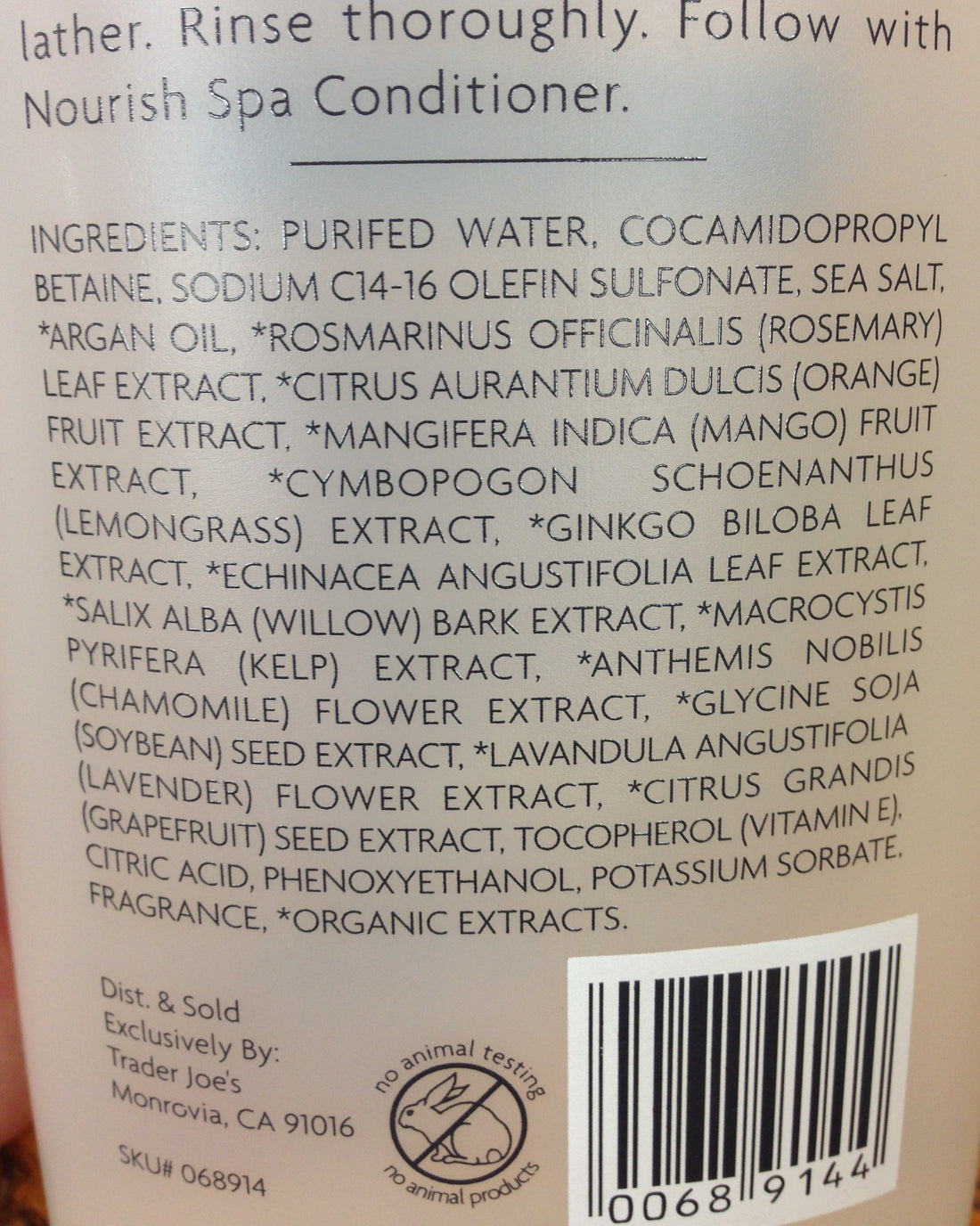
Why I Don't Buy Trader Joe's Soaps Right Now
Note: We love Trader Joe's and shop there all the time. The store is awesome and the people are great. (No, they're not paying us to say this!) But we don't buy the soaps they sell right now. Read below to find out why.
Recently, I was in my favorite store (Trader Joe’s, love them!) and did a little snooping around in their soaps department. I was kind of shocked when I looked at the list of ingredients in their soaps.
"Trader Jacques" Savon de France Ginger Almond Oatmeal Exfoliant Bar

From my viewpoint, there’s only one Trader Joe’s-branded soap that probably doesn’t have harsh ingredients: their Ginger Almond Oatmeal Exfoliant bar soap marketed under their “Trader Jacques” Savon de France label. However, I don’t know what fragrance they’re using (they’re not required to specify that on the label), and they don’t list their complete ingredients list.
Ingredients: “Contains: pure vegetable oils (olive, palm, and coconut oils, oatmeal, fragrances and/or essential oils.”
Interestingly, they don’t list lye (sodium hydroxide) which is a key ingredient for making this kind of soap. Probably a label typo – a significant omission, since it’s a necessary ingredient. Maybe it’s not a complete list of ingredients? Not sure. I didn’t see ingredients listed elsewhere on the label.
So, here’s a roundup of the OTHER soaps I found on the shelf, and what’s in them, and why I wouldn’t recommend purchasing any of them. (Statements of fact, presented below, are from the sources noted at the end of this article.)
Trader Joe’s Next to Godliness Oatmeal & Honey Soap Pure Vegetable


Ingredients: Sodium Palmitate, Sodium Palm Kernelate, Water, Glycerin, Essence of Oatmeal, Oatmeal Flakes, Honey, Sodium Chloride, Pentasodium Pentetate.
(In case you're wondering "where's the lye?" -- let me explain. "Sodium Palmitate" means "Palm Oil that's been mixed with Sodium Hydroxide (lye) and is now soap." Similarly, "Sodium Palm Kernelate" means "Palm Kernel Oil that's been mixed with Sodium Hydroxide and made into soap." So it's actually there, it's just listed differently.)
Of all these ingredients, the only potentially irritating ingredient is Pentasodium Pentetate. According to the “Final report on the safety assessment of pentasodium pentetate and pentetic acid as used in cosmetics,” published in the 2008 International Journal of Toxicology, “Pentasodium Pentetate is nonirritating to moderately irritating…” Also, “Pentasodium Pentetate [applied] to shaved and abraded rabbit skin produced moderate erythema after the first week and throughout the study, but no systemic toxicity.” WHAT THIS MEANS is they tested it on rabbits by shaving and scraping the rabbits’ skins, then applying the diluted chemical, and a week later the rabbits developed skin redness from inflammation or infection (erythema), and it didn’t go away but lasted the entire four weeks of the study, but it didn't kill them. (See references.)
Why Pentasodium Pentetate? It’s added to help make more suds by overcoming water hardness. But you don’t need suds to get clean, you need soap. A well-formulated soap will clean regardless of suds, and most will produce lather even in the hardest water conditions. (We have very hard water at my home yet my own soaps lather well.)
Trader Joe’s Tea Tree Oil Pure Vegetable Soap
Ingredients: Sodium Palmitate, Sodium Palm Kernelate, Water, Glycerin, Tea Tree Oil, Sodium Chloride, Pentasodium Pentetate.
Look at that: Pentasodium Pentetate. ‘Nuff said.
Dr. Bronner’s Magic Soaps “All-One Hemp Peppermint” PURE-CASTILE SOAP “Made With Organic Oils”

Ingredients: Organic Coconut Oil, Organic Palm Oil, Sodium Hydroxide, Water, Mentha Arvensis, Organic Olive Oil, Organic Fair Deal Hemp Oil, Organic Jojoba Oil, Organic Peppermint Oil, Sea Salt, Citric Acid, Tocopherol.
Actually, my issue with this soap is what I consider to be confusing labeling. “Pure Castile Soap” means 100% Olive Oil soap, but this has a very small amount of Olive Oil (notice it’s listed as the SIXTH ingredient, even after Mentha Arvensis (wild mint). The Merriam-Webster dictionary defines “pure” as: “unmixed with any other matter.”
I have also noticed that this brand is a bit harsh on the skin, as in the skin feels very "squeaky clean" which for dry skin types is a bit much.
Bisous de Provence Lavender with flowers Lavande Triple Milled Soap 100% Pure Vegetable Enriched with Shea Butter Made in France

Ingredients: sodium palmate, sodium palm kernelate, water (aqua), fragrance (parfum), lavender hybrida (lavender), sodium chloride, glycerin, butyrospermum parkii (shea butter), tetrasodium EDTA, tetrasodium etidronate.
The last two ingredients caught my attention. Tetrasodium EDTA on Safety Data Sheets has been linked to respiratory illness (increased asthma and sinus irritation), increased penetration of chemicals through the skin, and leaching calcium from the blood. (See references.) Tetrasodium etidronate has a similar warning. Both are used to soften water and therefore increase lather and sudsiness. But they’re not necessary, as noted above. Etidronate disodium (chemically similar, but not exactly the same) is used in some forms of drug treatment for osteoporosis. It has many cautions, such as not using it for very long, because it can – if used improperly – aggravate osteoporosis and lead to jawbone rotting or legbone fractures, especially in post-menopausal women. (See references.) I know, it sounds disgusting. Hope you never need to take that drug.
Please note that of course Safety Data Sheet (industrial usage safety document) and drug warnings are not the same as a rinse off skin product but we do not use these ingredients ourselves due to irritation concerns.
One more thing: glycerin is added – but you know what? Glycerin is a natural by-product of soap making and doesn’t need to be added unless it was removed earlier in the process. So I suspect the way this soap was made, the glycerin was removed, but then it needed to be added back because it helps moisturize the skin. Typically in this process you won't be adding more than a couple percent of glycerin vs the 10+ percent possible with small batch soap making, which will make these types of large scale manufactured soaps much less moisturizing overall.
CONCLUSION: I love shopping at Trader Joe’s and I’ll keep doing so. But I don’t buy soap there.
References
Pentasodium Pentetate
http://www.ncbi.nlm.nih.gov/pubmed/18830865 “Final report on the safety assessment of pentasodium pentetate and pentetic acid as used in cosmetics.”
Tetrasodium EDTA
http://ps.oxfordjournals.org/content/52/2/540.abstract “Extraction of Calcium from Blood Fibrin with a Solution of Tetrasodium-Ethylenediaminetetraacetate (Na4EDTA)”
http://www.ncbi.nlm.nih.gov/pubmed/22431256 “Occupational rhinitis and asthma due to EDTA-containing detergents or disinfectants.” (Note: rhinitis is irritation and inflammation of the mucous membrane inside the nose.)
http://www.ncbi.nlm.nih.gov/pubmed/17087380 “Heavy metal displacement in EDTA-assisted phytoremediation of biosolids soil.” (Gives information about how EDTA helps take heavy metals out of soil and deposit them in the water. It will do the same with your water supply – taking heavy metals out of the water and put it onto your skin, which you then hopefully wash away very thoroughly.)
http://www.truthinaging.com/ingredients/tetrasodium-edta “The Cosmetics Database considers Tetrasodium EDTA a low to moderate hazard ingredient, depending on its usage. It notes concerns regarding cancer, enhanced skin absorption, organ system toxicity and irritation (due to animal studies that showed skin irritation at low doses). It is classified as a high human health priority and expected to be toxic or harmful.” http://www.chm.bris.ac.uk/motm/edta/synthesis_of_edta.htm “EDTA is synthesized on an industrial scale from ethylenediamine, formaldehyde, and a source of cyanide such as HCN or NaCN.” (Note: HCN = Hydrogen cyanide; NaCN = Sodium cyanide) http://www.bubbleandbee.com/topfivechemicals.html “Tetrasodium EDTA is a preservative that’s made from the known carcinogen, formaldehyde and sodium cyanide. It is also a penetration enhancer, meaning it breaks down the skin's protective barrier, going right into your bloodstream.”
Trisodium etridronate
http://www.ncbi.nlm.nih.gov/pubmed/12396676 “Final report on the safety assessment of EDTA, calcium disodium EDTA, diammonium EDTA, dipotassium EDTA, disodium EDTA, TEA-EDTA, tetrasodium EDTA, tripotassium EDTA, trisodium EDTA, HEDTA, and trisodium HEDTA.” “These chelating agents are cytotoxic and weakly genotoxic, but not carcinogenic.” (Meaning, “these chemicals are cell-killing and weakly gene-killing, but not cancer-causing.” God, I hope so!)

